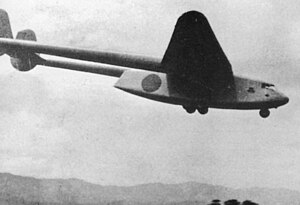| Ku-7 Manazuru Ki-105 Otori | |
|---|---|
 | |
| General information | |
| Type | Transport glider (Ku-7) Transport aircraft (Ki-105) |
| National origin | Japan |
| Manufacturer | Kokusai |
| Number built | 2[1] |
| History | |
| First flight | 1942 |
| Variants | Kokusai Ki-105 |
The Kokusai Ku-7 Manazuru (真鶴 "white-naped crane"; Allied code-name Buzzard) was a large, experimental twin boom Japanese military glider.
Design and development
[edit]An enlarged version of the earlier Maeda Ku-1 glider, it was developed during 1942. The use of a twin boom design allowed for a large, square cargo door, which meant that the aircraft was capable of carrying either thirty-two soldiers, 7600 kg of cargo, or even a light tank. It required a powerful towing aircraft, either the Nakajima Ki-49 or the Mitsubishi Ki-67, which were in short supply. As a result, the aircraft were modified by fitting them with engines, which were designated the Ki-105 Ohtori (鳳 "Phoenix").[2] Intended for use as fuel transports, only nine, of 300 ordered, were produced before development priorities were shifted elsewhere.[3]
Variants
[edit]- Ku-7: Large experimental military transport glider.
- Ku-7-II: Original designation for the Ki-105.
- Kokusai Ki-105 Ohtori: Long-range fuel tanker aircraft, powered by 2x 940 hp (700 kW) Mitsubishi Ha26-II 14-cylinder radial engines; nine built. Maximum take-off weight:12,500 kg (27,600 lb); normal payload:3,300 kg (7,300 lb); cruising speed:220 km/h (140 mph; 120 kn); maximum range: 2,500 km (1,600 mi; 1,300 nmi).[3]
Specifications (Ku-7)
[edit]Data from Encyklopedia Uzbrojenia,[4] Japanese Aircraft of the Pacific War[3]
General characteristics
- Crew: 2
- Capacity: 32 troops, equipped / 8 short tons (7,300 kg) tank / 75 mm (3.0 in) howitzer with 4 short tons (3,600 kg) tractor / 7,464 kg (16,455 lb)
- Length: 19.5 m (64 ft 0 in)
- Wingspan: 34.75 m (114 ft 0 in)
- Wing area: 119.7 m2 (1,288 sq ft)
- Aspect ratio: 10.8
- Empty weight: 4,536 kg (10,000 lb)
- Gross weight: 12,000 kg (26,455 lb)
Performance
- Never exceed speed: 354 km/h (220 mph, 191 kn)
- Maximum towing speed: 201 km/h (125 mph; 109 kn)
See also
[edit]Aircraft of comparable role, configuration, and era
References
[edit]- ^ Rottman, Gordon L.; Akira Takizawa (2005). Japanese Paratroop Forces of World War II. Elite. Vol. 127. Botley, Oxford: Osprey Publishing. p. 12. ISBN 978-1-84176-903-5.
- ^ Donaldson, Graham (2000). "The Japanese paratroopers in the Dutch East Indies, 1941-1942". The Netherlands East Indies 1941-1942. Archived from the original on 2015-07-08. Retrieved 29 April 2007.
- ^ a b c Francillon, Rene (1979). Japanese Aircraft of the Pacific War. London: Putnam & Company Limited. p. 485. ISBN 0-370-30251-6.
- ^ Skrzypacz, Marcin (2005). "Kokusai Ku-7 "Manazuru"". Archived from the original on 17 May 2008.